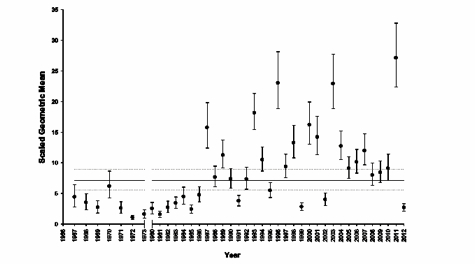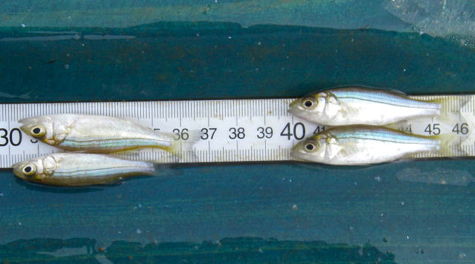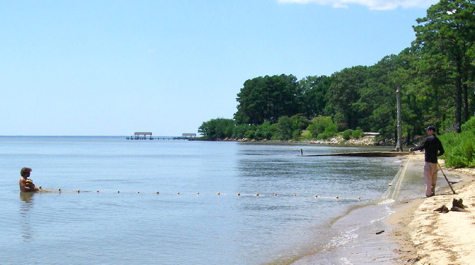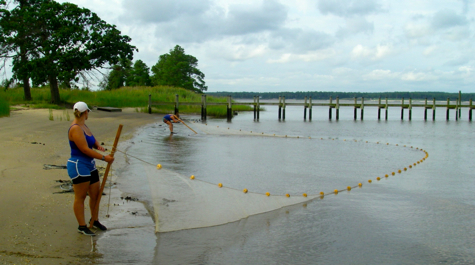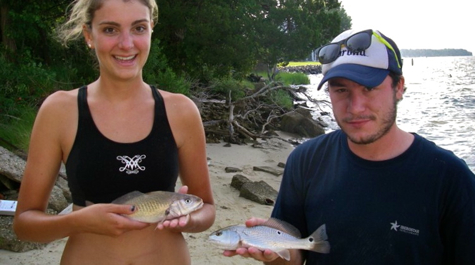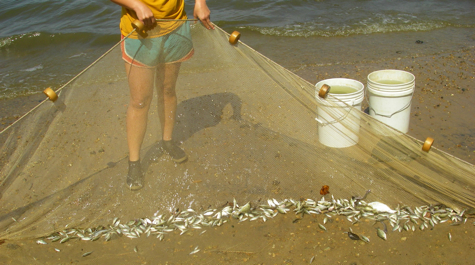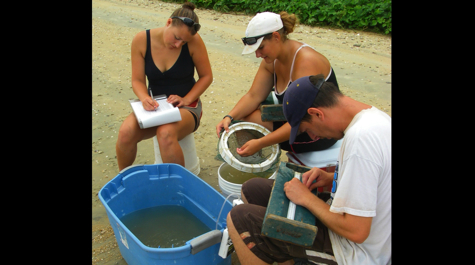An “off” year for juvenile striped bass in Virginia waters for 2012
Scientists say drop in number of young-of-year fish likely reflects natural variability
Preliminary results from a long-term survey conducted by researchers at the Virginia Institute of Marine Science suggest poor striped bass production in Virginia tributaries of Chesapeake Bay in 2012. The 2012 year class represents the group of fish hatched last spring, which will grow to fishable size in 3 to 4 years.
Poor production was also reported in 2012 for the upper Bay and its tributaries in a sister survey conducted by the Maryland Department of Natural Resources.
VIMS’ Juvenile Striped Bass Seine Survey recorded less than 3 fish per seine haul in 2012; significantly lower than the historic average of roughly 7 fish per seine haul. This is a notable decrease in annual recruitment when compared with recent years in which catches of young fish were rated average or above average. Just last year in 2011, an exceptionally strong year class was produced in Virginia waters. Year-class strength was also high in 2011 in Maryland and North Carolina.
Professor Mary Fabrizio, who directs the VIMS survey, says, “Poor recruitment during 2012 is consistent with patterns observed by our long-term monitoring program. Since the fishing moratorium for striped bass was lifted in 1990, single years of low recruitment have occurred approximately every 10 years, with the last one occurring in 2002.”
“A single poor year of recruitment like we saw this year can be weathered by the previous year’s high production,” says Fabrizio. “It would take 3 continuous years of poor recruitment to trigger management actions to identify and address issues of striped bass spawning success.”
Leonard Machut, who manages the survey’s day-to-day operation, adds, “Striped bass recruitment can vary considerably from year to year. Poor recruitment in 1999 and 2002 followed above average recruitment in 1998 and 2001. Recruitment then rebounded in the following years. Striped bass populations, and the fisheries they support, are stabilized by strong year classes, which offset the influence of less productive years.”
Striped bass play an important role as a top predator in the Chesapeake Bay ecosystem, and provide value to numerous commercial and recreational anglers. Fabrizio notes that the economic and ecological value of striped bass lends significant interest to the year-to-year status of their population. "By estimating the relative number of young-of-year striped bass," she says, "our survey provides an important measure of annual and long-term trends in the Bay's striped bass population."
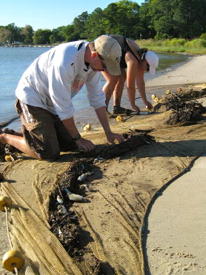 The VIMS Juvenile Striped Bass Seine Survey currently
samples 18 stations in the Rappahannock, York, and James rivers. Each year,
biologists sample each site 5 times from early July through mid-September,
deploying a 100-foot-long seine net from the shore. They count each netted
fish, measure its fork length (the distance from snout to the fork in the
tail), and return it to the water. These young striped bass generally measure
between 1.5 and 4 inches long. Survey scientists measured 408 juvenile striped
bass at these stations in 2012. VIMS has been conducting the survey annually
since 1967 for the Virginia Marine Resources Commission (VMRC).
The VIMS Juvenile Striped Bass Seine Survey currently
samples 18 stations in the Rappahannock, York, and James rivers. Each year,
biologists sample each site 5 times from early July through mid-September,
deploying a 100-foot-long seine net from the shore. They count each netted
fish, measure its fork length (the distance from snout to the fork in the
tail), and return it to the water. These young striped bass generally measure
between 1.5 and 4 inches long. Survey scientists measured 408 juvenile striped
bass at these stations in 2012. VIMS has been conducting the survey annually
since 1967 for the Virginia Marine Resources Commission (VMRC).
The Bay's striped bass population has rebounded from historic lows in the late 1970s and early 1980s, following fishing bans enacted in Delaware, Maryland, and Virginia in the mid- to late-1980s. Since then, the Bay's striped bass population has increased to the point that striped bass are now considered recovered. The recovery of striped bass in the early 1990s can be partially attributed to a few strong year classes produced in the late 1980s.
Monitoring of juvenile striped bass recruitment will continue next year to provide managers with crucial information to sustainably manage this sentinel Bay species. “We’re eager to see juvenile striped bass recruitment bounce back to near average or above average conditions in 2013,” says Machut.
For more information about the Virginia Juvenile Striped Bass survey visit the survey's webpage at http://bit.ly/vims_jsbs

